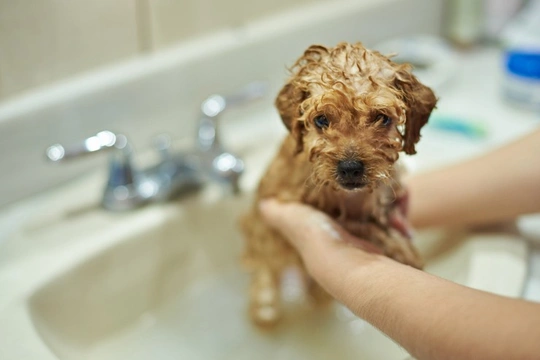
How to give your puppy or young dog their first bath
All dogs need to be bathed from time to time – some dogs every few weeks, whilst for others, bath time might only happen a couple of times a year. How dogs view and react to bath time can make all of the difference in terms of how difficult the whole process is too, and whether your dog gets overexcited, finds it very stressful and makes it harder than it needs to be, or takes the whole thing in their stride.
While many dog owners prefer to take their dog to a grooming parlour when they need a bath, and this is totally fine, when it comes to your puppy or young dog’s first bath, how you handle and manage it all is very important. Your pup’s first experience of having a bath will set the tone for the future, and making an error or upsetting your dog the first time can cause a range of problems further down the line.
This means that getting your pup’s first bath right – both in terms of how you manage the bathing itself and how you handle your dog – can help to ensure that they are tolerant of being bathed in the future. In this article, we will share the basics of how to give your puppy or young dog their first bath, to give them the best possible start and introduction to the whole process for the future. Read on to learn more.
The environment
Choosing where to bathe your pup for the first time is the first challenge – you will need to pick somewhere that you can get your dog in and out of with ease, be able to secure them, and have everything you need to hand. A large sink (ideally with a shower attachment) or a bath, again with a shower mixer, are better choices than a shower cubicle, because you will have more room to move and a better chance of keeping your dog calm and under control.
You should also ensure that you have everything you need to hand, including towels, leads and a means of securing your pup before you get started.
The water
Getting the water temperature right is a vital part of making bathing a pup comfortable and enjoyable – too cold and your pup will be uncomfortable, and too hot, and they may get hurt as well as finding things frightening. Ensure that the water temperature is perfect before you bring your dog in – and start off with just a couple of inches of water in the sink or tub, so that your dog can stand in the water without losing their footing.
Place your pup in the water and praise them, allowing them time to get used to the sensation before you start to get the rest of their body wet, and do this slowly and gently. Ensure that your pup has been brushed or combed beforehand, so that they are not knotty or matted, giving you more to think about in the bath itself.
As the bath progresses, you can use the shower head (after running it to ensure that the water temperature is appropriate and consistent) to thoroughly get them wet and begin applying shampoo, but always keep your dog’s face dry and keep water and suds out of their eyes and ears.
Shampoo and other products
You should always use a very gentle shampoo for any dog, and this is particularly important for puppies, so ask your vet for advice or choose a shampoo specifically designed to be mild and safe for dogs. The same goes if you wish to use conditioner for your dog too, and when it comes to applying the products themselves, use the smallest amount possible and add more if needed, rather than covering your dog in suds that will take forever to wash out!
Washing every last trace of shampoo and other products out of the coat is vital too – and if your dog has very thick, long or dense hair, this can take some time, so ensure that you will have enough hot water!
Drying
You must dry your pup off fully after their bath, and not simply rub them off and leave them to it. Your pup will find the sensation of the water itself very strange, and is likely to shake several times throughout the process and whilst you are drying them, so prepare for this and don’t tell them off when they do it!
Use soft towels to blot and rub as much water off as possible, squeezing longer hair and making sure that you get between the armpits and under the belly. You can then either use a hair dryer on a low heat and reasonably quiet setting to dry your pup off – although it is wise to get them used to the sound of the hair dryer well in advance of their bath – or put them in a small, warm room or near to a radiator to get dry, although this takes longer.
Handling and managing your pup
A successful first bath will still be a rather odd experience for your puppy, and as is the case when dealing with any unknown, how you react and act will inform your pup’s responses too, as they will take their cues from you.
Be calm, business-like and reassuring without pandering to your pup’s reactions – behave as if everything is normal and there is nothing to make a fuss about. Try to keep your pup entertained with attention, and perhaps a toy or a few treats while they are in the bath, and don’t get irritated or anxious, nor be overly stern or annoyed with your pup either.
Once they are out of the bath, give them plenty of praise and some treats, as well as drying them off thoroughly before they do anything else!



